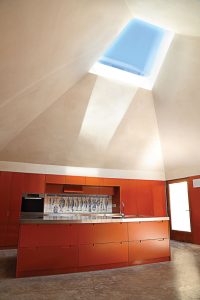Kathryn Muller of The Rooflight Company discusses how bespoke design can allow housebuilders and developers to push the boundaries of aesthetics on their schemes.
‘Bespoke’ – designers, developers and architects love the word. It means breaking conventional rules and resetting boundaries, thereby allowing creativity to run free. It means elevating your work by creating features that are utterly unique.
In truth, however all that ‘bespoke’ really means is a product that is made to order, crafted especially to cater to the customer’s wants and needs. Associated with that, sometimes unfairly, is longer lead times and higher costs.
The truth is though, bespoke designs can be used in every room of a home; there are no boundaries after all. From unique staircases that create a focal entryway and hub of a property, to handcrafted kitchen units that make the most of the space available, and statement custom lighting to create the perfect ambience, there is no end to the possibilities available.
Not every project will require the bespoke treatment when working with manufacturers who have a vast range of off-the-shelf options. However, for those times when a design needs an added ‘wow factor,’ or when updating an older property and things are found to be not quite ‘square,’ or when an ambitious architect’s vision is slightly more complicated than initially thought, that’s when a manufacturer with bespoke offerings shines.
Bespoke allows designers to create products with added capabilities. For rooflights, this could be increased acoustic or thermal performance, or even options like obscured glass, security glass and switchable glass, which transitions from transparent to opaque at the flick of a switch. This flexibility means housebuilders can use skylights in less traditional areas of a home, such as dressing rooms and even music studios.
Bespoke also allows housebuilders and architects to bring creative and inspirational ideas to life. After all, if you are going down the bespoke route, then you have the opportunity to provide more than just ordinary, so make the most of it.
Not all bespoke designs are extreme though, it can just mean ‘perfectly tailored to a property.’ Designs could be drawn up for an orangery or sunroom, but a standard size skylight may not be quite big enough. Or perhaps instead of something square, the architect wants a geometric shape to add interest and personality to the property. That’s when a bespoke design team can help out.
They’ll be able to walk the customer through the entire process, from an initial conversation where they will go over the aim of the project, to the minute detail of the fixtures and fittings. Indeed, it may not be obvious from the outset that a project requires bespoke. It may be that you approach the sales team with an idea, looking for advice on how to deliver on the brief. At that point they may point you in the direction of their bespoke team so that the final product truly reflects the initial concept.
Sometimes the design team will work with a third-party surveyor to create a 3D model of the roof to ensure the calculations are as precise as possible before the product is made. Using CAD software allows design teams to import a 3D model of the property to a computer to ensure that the measurements are correct and any rooflights will seamlessly fit into the space available without warping or twisting the units. This is just one example of how the design process works, but it will differ depending on the product or feature being made.
Sure, the process of going down the bespoke route can be more laborious in terms of time invested. It isn’t as simple as going into a shop and taking something off the shelf. However, you will be collaborating with seasoned craftspeople and ensuring that the product is the perfect fit for the job and of the highest quality. There is something in that process which is really exciting. Whether it’s the thought that no other property will have the same feature, or the creative process itself. You don’t get that by shopping off the shelf.
So, if you’re in a position where you need to go bespoke, see it as an opportunity to take your design to the next level. Why blend into the building next door when you could stand out instead? Use bespoke to push the boundaries.
Kathryn Muller is Design Studio manager at The Rooflight Company

